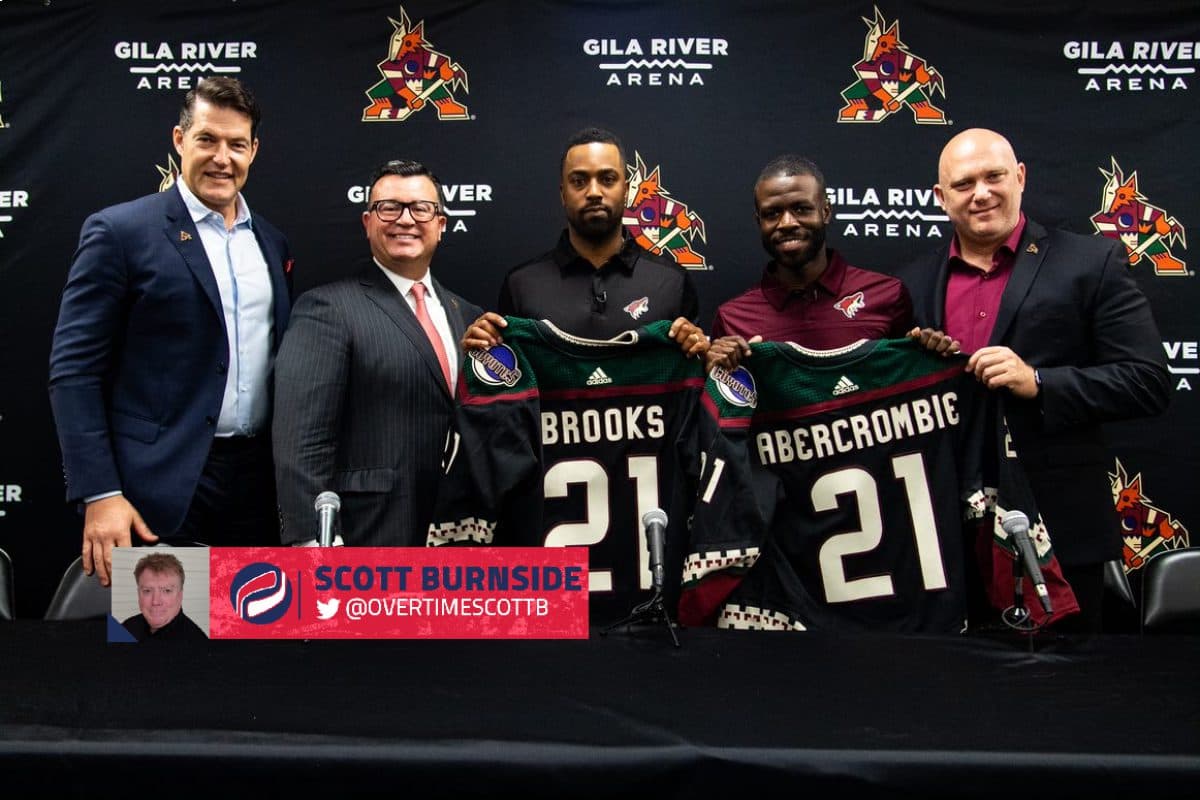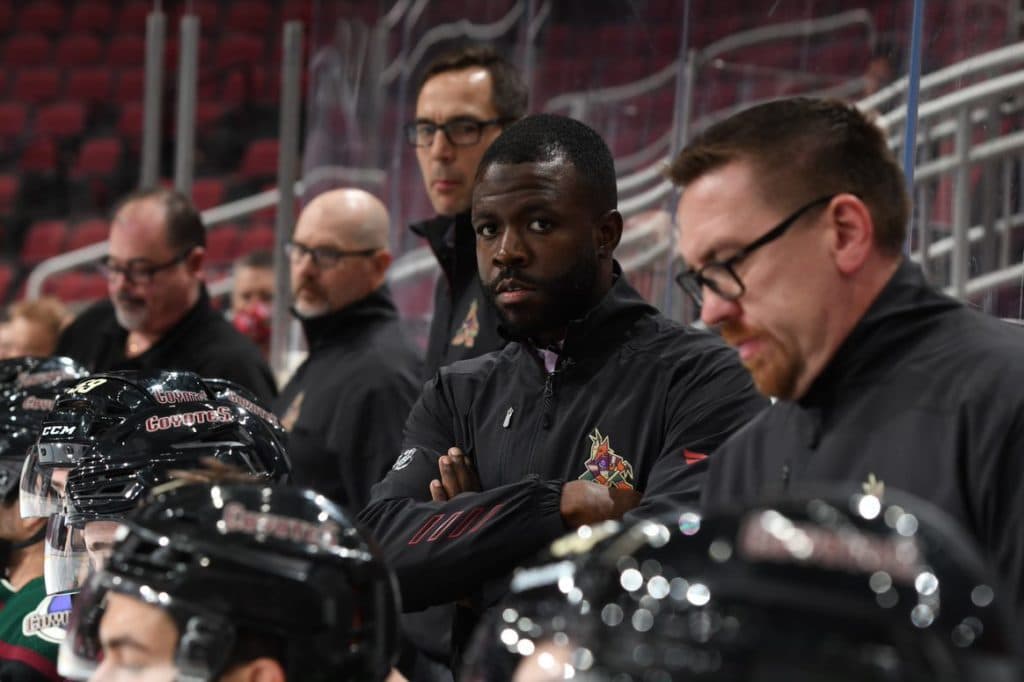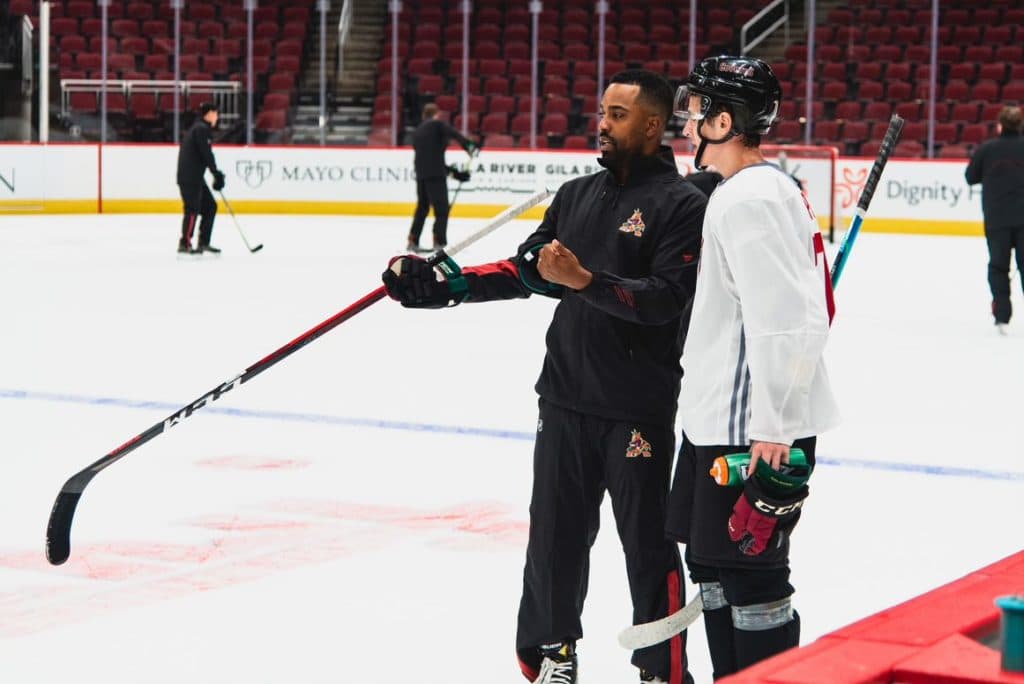Want to create more diversity in coaching? Here’s How

There are two moments early in the four-part documentary series NHL Bound we keep coming back to, moments that seem to bring into focus the complex nature of how to break down barriers that exist between people of color, women and other marginalized groups and top coaching jobs in hockey.
Duante’ Abercrombie, an assistant coach with Division III Stevenson University in Baltimore County, Maryland, is handed a computer tablet by filmmaker Kwame Damon Mason. In Toronto, Nathaniel Brooks, associate coach of the Ryerson Rams university hockey team, has a similar tablet.
The cameras roll as both men open up a message from Arizona Coyotes GM Bill Armstrong inviting them to come and join the Coyotes’ coaching staff at their development camp in Arizona.
You can see the look of surprise – perhaps disbelief is more accurate – as the cameras capture a rare moment of a door opening onto a new world.
For a week last fall, Abercrombie and Brooks, members of the National Hockey League Coaches’ Association’s BIPOC mentorship program, were embedded with the Coyotes during their development camp in Glendale.
They sat in on meetings with coaching staff and team executives from the Coyotes and their American Hockey League affiliate in Tucson. The helped plan and implement drills and practice sessions and each coached a team during a scrimmage near the end of their week with the team.
“If I’m being 100 per cent honest, thinking about it now still brings chills,” Abercrombie said of that moment when he saw and heard Armstrong’s invitation. “You get the opportunity to be in the room. You have a seat at the table. It’s a validation of the work you’ve done. Just being able to experience what it’s like to be in the NHL on a day-to-day, minute-by-minute basis, it’s the experience of a lifetime. It truly changes you as a person.”

It’s a complicated thing to create opportunities for men and women of color and/or people of different sexual orientation within the machinery of a traditionally white, straight, male game like hockey. And the path from believing that making the game more diverse and inclusive is a good thing to making it a reality and tangible is a rocky one and takes longer to traverse than many people would like.
NHL Bound and all those involved in creating this experience represents a watershed moment in that process, creating exponential growth in opening up opportunities for coaches representing underserved communities.
The most important factor in a coach’s career advancement is making connections to other coaches at higher levels of competition, said Lindsay Artkin, president of the NHL Coaches’ Association.
“If you don’t have those networks, you’re never going to get those opportunities,” Artkin said.
That week in Arizona last fall helped shatter those barriers for Abercrombie and Brooks, and the telling of their story helped create a template that other teams can use to carry out their own programs.
The genesis for this ambitious project goes back to the NHLCA’s initial mentorship program that connected female college coaches with members of NHL coaching staffs. The mentorship was done mostly remotely during the pandemic, but the exchange of ideas and presentations on varied elements of coaching were so popular the NHLCA expanded to include a mentorship program for BIPOC (Black, Indigenous and people of color) coaches at various levels.
In total there are 110 coaches involved in both mentorship programs, including Abercrombie and Brooks.
The next step was to actually put some of these coaches in the workplace at the highest level. The idea: let them meet other coaches at the NHL and AHL level; let them interact with NHL prospects and see how an NHL organization operates; let them develop the kinds of contacts and relationships that would otherwise have been denied them.
Mason, whose Soul On Ice documentary is required viewing for anyone interested in the history of the intersection of the Black community and hockey, had been in contact with Arizona Coyotes president and CEO Xavier Gutierrez about telling the stories of hockey’s under-represented and was aware of the mentorship program.
Mason wanted to follow Abercrombie and Brooks from the moment they were informed they would be going to an NHL development camp through to their final exit from the week-long mentorship exercise.
Great idea. But would it work?
The reality is you can’t force a relationship or a bond. You can’t make people click. But after the first day that simply wasn’t an issue.
“They fit right in,” Armstrong said. “Their personalities are infectious. They’re two guys that just love hockey. Our coaches gravitated to them right away and were willing to share their knowledge and bring them in with the coaching staff.”
Armstrong was on board from the get-go. He had gone through a similar process near the end of his playing days as he was transitioning into coaching himself. Peter Laviolette, who was the head coach with Providence, Boston’s AHL affiliate, invited Armstrong to come to the Bruins’ training camp and hang out with the coaches, including future Hall of Famer Pat Burns, Bobby Francis and longtime NHL defenseman Jacques Laperriere. Armstrong, who would go on to coach in Providence and Trenton of the ECHL before beginning his management journey, was with the group less than a week.
“But I learned a lifetime of knowledge,” Armstrong said. “I just remember the impact it had on me.”
He saw the same possibilities in what was in store for Abercrombie and Brooks.
“This is a no-brainer for these guys – they’re going to learn a lifetime of knowledge in a week,” Armstrong said. “And they’re going to bring that back to their community. The smarter they are, the smarter the hockey player they will be able to make.”
The cameras bear out Armstrong’s assessment.
“The beauty of NHL Bound is just the fact these guys have an opportunity to show themselves as people and show their ability on the ice,” Mason said. “It was just like, ‘Boys, go ahead and do your thing.’ That was very gratifying for me to see.”
The filmmaker knew it was working when Brooks and Abercrombie were ignoring his texts about going out to dinner in Arizona and he ended up eating takeout food in his hotel alone while Abercrombie and Brooks were out socializing with the coaching staff.
“It was funny, and I’ll tease them about that,” Mason said with a laugh.
Brooks, who grew up in the Metropolitan Toronto area, played a year of major junior in Oshawa. He spent three years playing for York University in Toronto and a season in the Southern Professional Hockey League in Fayetteville for the FireAntz.
As his family grew, Brooks went from pursuing the dream as a player to pursuing it as a coach. In fact, he was in discussions to coach in Europe this past off-season, but that opportunity fell through just before he opened up that tablet and found Armstrong inviting him to Arizona.
“Everything happens for a reason,” said Brooks, 36. “This experience has started to open doors that maybe weren’t necessarily open before. I’m just thankful Kwame thought of me.”
Brooks reached out to people he knew in the game like former NHLer Chris Stewart and longtime NHL assistant Steve Spott. They told Brooks what development camp was like and encouraged him to be prepared but most importantly be himself.
“The involvement and interactions definitely exceeded my expectations,” Brooks said. “In the end, hockey is hockey. Hockey people are hockey people. It’s really easy for us to get along. That’s just the very basics of it. We quickly realized we speak the same language.”

Abercrombie, as it turns out, was part of a story I had written a couple of years back on Black coaches making their way in the game. There are shots in NHL Bound of Abercrombie as a boy wearing a Fort Dupont Ice Hockey Club jersey – part of the NHL’s Hockey Is For Everyone Initiative.
His family couldn’t afford AAA travel and skills sessions, so Abercrombie raised money online to help pay for a trip to Ontario, where he met Graeme Townshend, the first Jamaican-born player in the NHL. Abercrombie ended up working with Townshend at his camps as an instructor, and that started him down the path to coaching.
During my interview with Townshend, he described Abercrombie as “very, very intelligent. He just commands respect. The way he carries himself, you look up to him. You can’t help but look up to him.
“He’s going to be in the NHL.”
Abercrombie, 35, was gratified at how seamlessly he and Brooks integrated into the rhythm with the other coaches. Abercrombie is an admitted face-off nut, and he found himself in a number of conversations about that critical part of the game, offering his opinion while listening to the experiences of the others.
“It was very heartwarming. And honestly inspiring. And it humbles you,” Abercrombie said. “If these guys can be so open with their knowledge and their time, given who they are,” there’s no excuse for coaches further down the ladder to be stingy with their time with other coaches who want to learn.”
A few months after the development camp, Artkin and NHLCA executive director Michael Hirshfeld met with Armstrong, Gutierrez and longtime Coyotes captain and current team executive Shane Doan to do a post-mortem on their experience with the outside coaches.
The feedback was universally positive.
Armed with the NHL Bound series, Artkin recently spoke to executives from all 32 NHL teams. Arizona is committed to hosting coaches for a second time while four other NHL clubs are on board to open their doors as well.
This time the roster of new coaches looking to set foot in the NHL world will include female coaches likely from the collegiate ranks.
“The most exciting part is not really knowing where this is all going to go,” Artkin said. “You can just feel the momentum that is coming.”
At some point, though, Artkin and Kim Davis, the NHL’s senior executive vice-president of social impact, growth initiatives and legislative affairs, agree it will culminate in spots on NHL coaching staffs. It’s a matter of when not if.
Davis has been with the league four years now, and the issue of how to get more diversity into the game, from players to coaches to executives, is at the heart of her mandate. She believes the NHL Bound/coaches’ mentorship program is an important building block.
“Honestly, we’ve been working behind the scenes on this from the very beginning,” Davis said.
Davis has often been asked about the NFL’s Rooney Rule and whether the NHL needed to follow a similar pattern to require teams to consider minorities for coaching positions. Her answer has consistently been no.
“I know so much more today than I knew four years ago, but it was very much an answer rooted in my instincts that, first of all, the Rooney rule wasn’t working for the NFL as we have come to know,” Davis said. Our biggest challenge was getting our sport and league exposed to the number of coaches of color that existed at the collegiate, at the amateur, at the youth level that had a tremendous amount of experience and just needed additional nurturing and exposure and access in order to move into these seats of opportunity and power at the NHL.
It’s not just about broadening exposure for the coaches down the line but also the NHL clubs themselves.
“When you expose people to talent (like Abercrombie and Brooks) that they otherwise haven’t yet had exposure to, when that talent has the opportunity to be in the room, often it’s a bigger eye-opener for those that sit in positions of power and authority than it is necessarily for that talent,” Davis said. “And so I wasn’t worried about Nate or Duante’ being able to show their stuff if, you will, because I knew that they were talented. They just needed the opportunity to have access to those networks.”
Brooks and Abercrombie continue to stay in contact with the coaches within the Coyotes’ organization.
And Brooks has already had some inquiries about coaching positions, although he’s reluctant to speak in more detail.
Abercrombie often stops in front of his closet and looks at the Coyotes’ gear that he wore during the Coyotes’ development camp – that’s if he’s not wearing it, of course – and it reminds him that his dream is so much more in focus now and it makes him more determined than ever to put in the work to see that dream fulfilled.
“You see the NHL logo on the sleeve, and it tells you ‘You’re here. This is real and this is your time,’ Abercrombie said. “That’s something I’ll never forget.”
The four-part series ends after a scrimmage between two squads, one coached by Brooks the other by Abercrombie. There’s a shot in the locker room after the scrimmage as the two prepare to pack up and head their respective ways.
“I don’t want to leave,” Abercrombie says.
It’s not just this arena, this locker room in Glendale, that the coaches long to stay connected to, but the NHL itself. And in time, maybe coaches like Abercrombie and Brooks, or the ones who will follow them through this path, will walk through NHL doors and never have to leave.